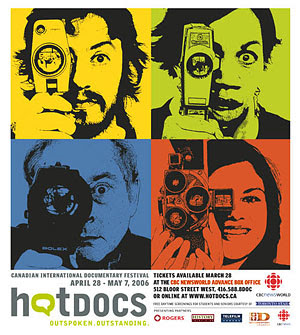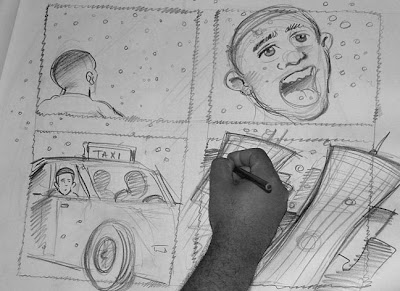 After watching the film (Bowling for Columbine), work in groups of 5-6. The goal is to create a 6-8-minute documentary film focusing on a hot topic. Each group should select a hot topic that they feel impacts them on their campus or in their lives. These hot topics can come from the film, from their exercises leading up to the film or can be anything the students want to explore.
After watching the film (Bowling for Columbine), work in groups of 5-6. The goal is to create a 6-8-minute documentary film focusing on a hot topic. Each group should select a hot topic that they feel impacts them on their campus or in their lives. These hot topics can come from the film, from their exercises leading up to the film or can be anything the students want to explore.BRAINSTORMING
The groups should meet and discuss their hot topic. They should break down the topic and ask each member of the group to be responsible for some research surrounding their topic that they can bring to class the next day. They should decide on a DRIVING QUESTION for their project, and this will guide the outcome of their film. For example, if the students are looking at the issue of drugs on campus, they might decide that the overall question they want to answer is “Why do some students refuse the offer of drugs whereas other students go as far as to carry drug use to school?” They need to decide on this driving question before they start interviewing and build smaller mini-questions related to it to guide their inquiry. (Mini-questions are 4-5 offshoots, more specific questions that help define the driving question.)
INTERVIEWING
Each group should create a list of 6-8 possible people to interview for their documentary and create a list of questions to ask these people. In the final film, they should include at least five interviews with a diverse interviewing group (i.e., don’t just interview other students, but have students, teachers, community members, the principal, etc.)
STORYBOARDING
 Each group should make some fingernail sketches of what they want the specific sections of their film to look like, but place each desired scene on a separate sheet of paper, so that they can decide later where they want the scenes to fall in their film. They will have a better understanding of the order in which they want their scenes the closer they get to filming.
Each group should make some fingernail sketches of what they want the specific sections of their film to look like, but place each desired scene on a separate sheet of paper, so that they can decide later where they want the scenes to fall in their film. They will have a better understanding of the order in which they want their scenes the closer they get to filming.Documentary Film Project
SCRIPTWRITING (TREATMENT/OUTLINE)
Students should first write an outline (the Treatment) of each interview. Next the student should write the text (voice-over that will surround each of their interviews as well as the lead-in to the film (like Michael Moore’s first voice-over) and a closing voice-over at the end of the film. The script will be a breathing thing as they move along in the process. They will add to it with each interview they decide to use.
FILMING
(If filming is not available, the students can act their scripts out live using actors to fill in for the people they interviewed; in this case, a script based on the actual interviews is essential.) Unless they have good editing programs to work with at home or at school, the students should film in order as much as possible.
Students should first write an outline (the Treatment) of each interview. Next the student should write the text (voice-over that will surround each of their interviews as well as the lead-in to the film (like Michael Moore’s first voice-over) and a closing voice-over at the end of the film. The script will be a breathing thing as they move along in the process. They will add to it with each interview they decide to use.
FILMING
(If filming is not available, the students can act their scripts out live using actors to fill in for the people they interviewed; in this case, a script based on the actual interviews is essential.) Unless they have good editing programs to work with at home or at school, the students should film in order as much as possible.
12 comments:
the script for our group is up on my blog sir
Sir I am done!
done:)
my group is done!
our group script is on kayla k's blogspot.
http://mabkayla.blogspot.com/
our group script is on kayla k's blogspot.
http://mabkayla.blogspot.com/
done
done...
sir, I did my work journals/log for our video documentary.
sir check my blog
done
4 the record... the video outline and the video r on my blog, FINALLY!:)
Post a Comment